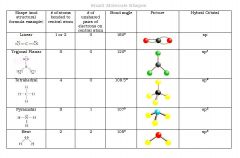![]()
![]()
![]()
Use LEFT and RIGHT arrow keys to navigate between flashcards;
Use UP and DOWN arrow keys to flip the card;
H to show hint;
A reads text to speech;
18 Cards in this Set
- Front
- Back
|
Atomic Number
|
Gives you the number of protons (b/c atoms are generally neutral in charge) # of protons = # of electrons |
|
|
Mass Number
|
Number of protons + # of neutrons
|
|
|
Proton
|
positive charge, 1 Dalton, inside the nucleus
|
|
|
Neutrons
|
no charge, 1 Dalton, inside the nucleus
|
|
|
Electrons
|
negative charge, 0 Dalton, outside the nucleus
|
|
|
Isotope
|
-element can exist in different forms (any of the atoms of an element with the same # of protons but different # of neutrons & different physical properties -All isotopes have SIMILAR chemical properties (same # of electrons) but different physical properties) |
|
|
Radioactive Isotope
|
-nucleus breaks down releasing subatomic particles (energy) in form of radiation -Each have a constant half light |
|
|
Half Light
|
-time it takes for half of a atom in a sample to decay -constant but varies between radioactive isotopes |
|
|
Electronegativity
|
force of attraction for electrons
|
|
|
Covalent bonds
|
share electrons
|
|
|
Non-polar bonds
|
type of covalent bond, share equally
|
|
|
Polar
|
-type of covalent bond, shared slightly unequally (slightly negative/slightly positive) -sides with the one with higher electronegativity |
|
|
Ionic
|
-transfer of electrons -one loses (positive/cation) and one gains (negative/anion) |
|
|
Electronegativity Difference
|
subtraction answer (subtract bigger from smaller)
|
|
|
Tetrahedral
|

|
|
|
Intramolecular Bonds
|
bonds within the same molecule -covalent and ionic bond |
|
|
Intermolecular Bonds
|
bonds between different molecules -London dispersion, dipole-dipole, and hydrogen bond |
|
|
London Dispersion
|
occurs between nonpolar molecules and noble gases. Caused by random
|

